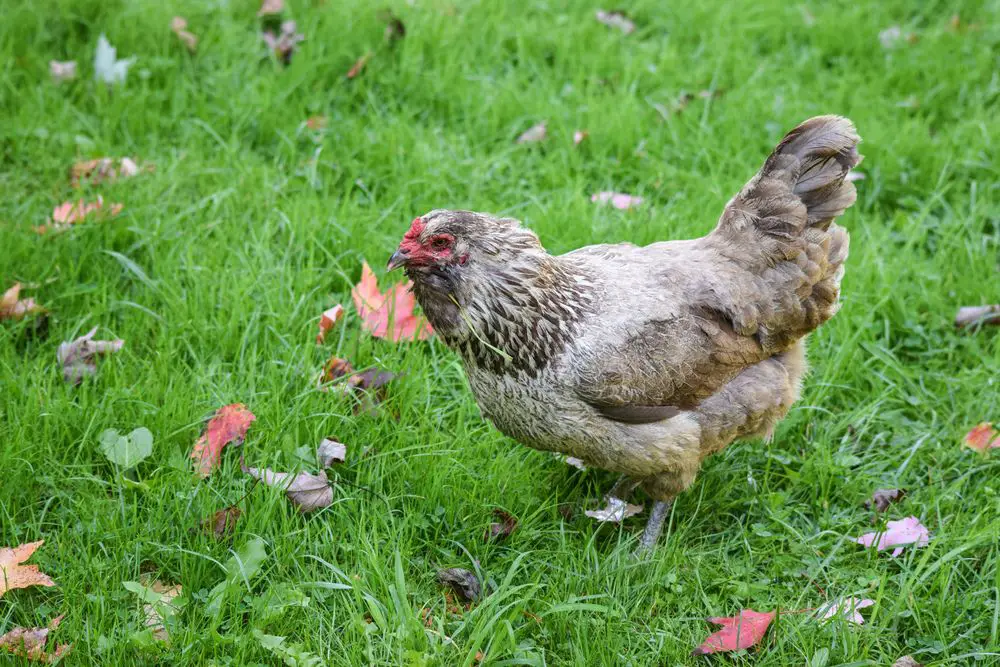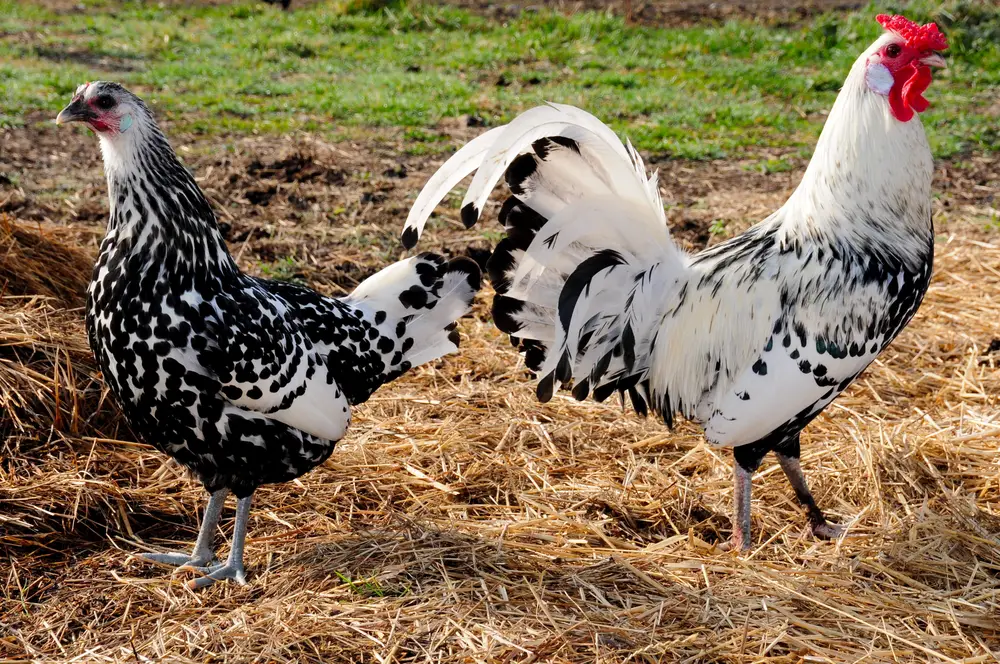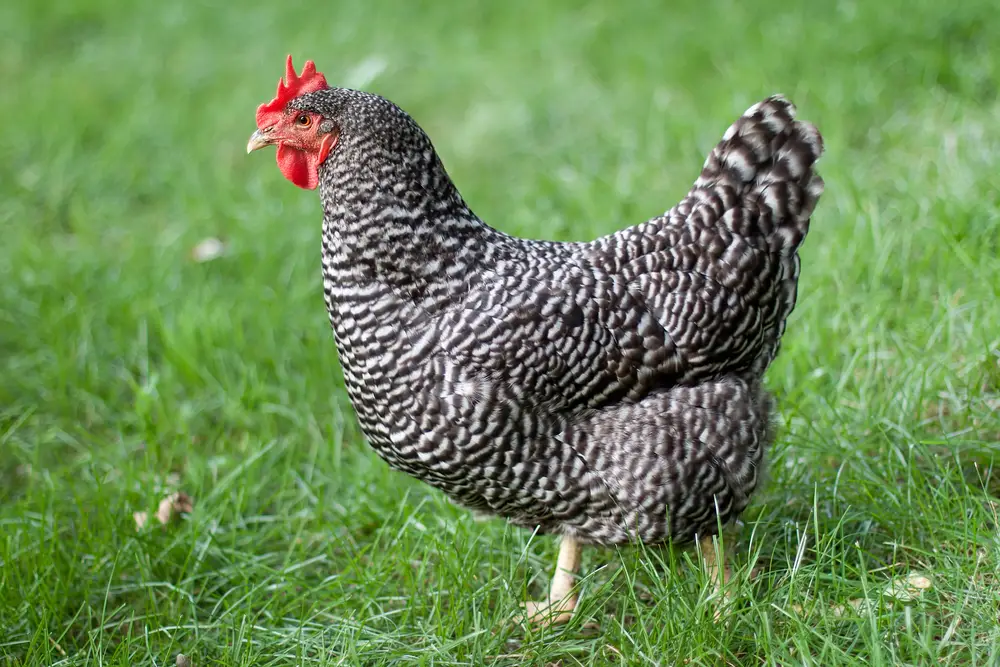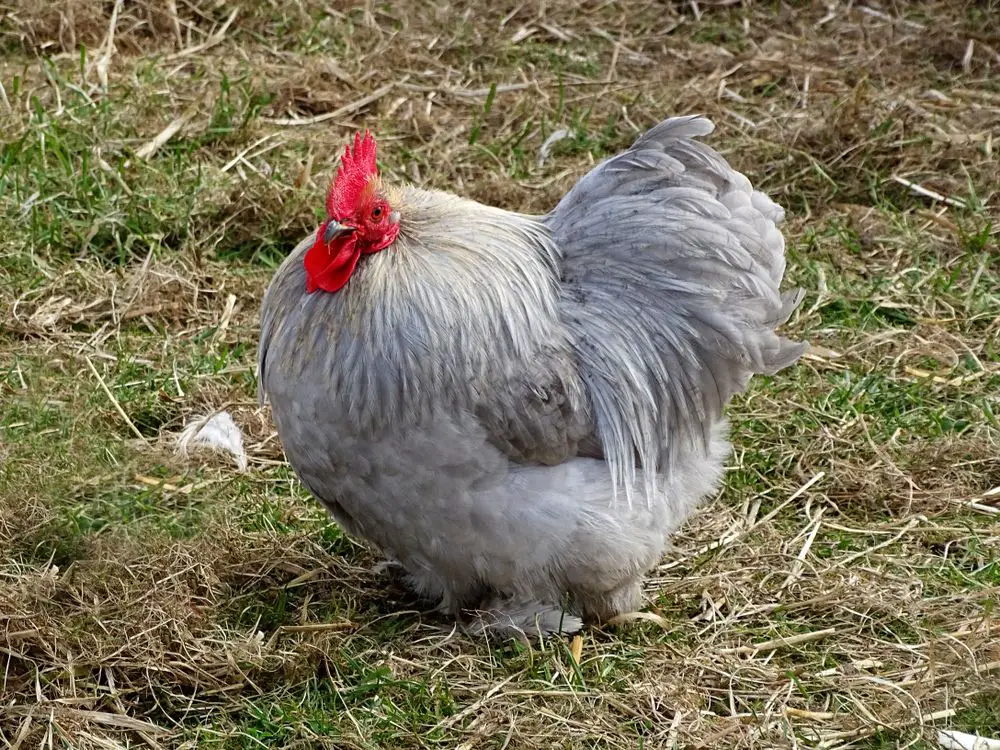Grey chicken breeds are among the most beautiful breeds of chicken, and the gray color they display is usually a result of a mix of different colors. Gray chickens can be found in many different breeds, and several are dual-purpose chickens that are useful for egg laying and meat production.
The American Poultry Association doesn’t recognize many breeds as Gray chickens, but rather Blue Chickens or Lavender Chickens, which lend a gray color to the chicken.
If you’re interested in finding a gray chicken breed for your backyard chicken coop, look no further!
Table of Contents
All Gray Chicken Breeds
Australorp Chicken
Known as the Australian Orpington chicken, Australorps are large, dual-purpose birds with iridescent feathers. They are the most popular chicken in Australia and are beloved worldwide.
The blue variety of Australorp has feathers with a gray appearance but is quite rare and may be hard to find.

| Temperament | Friendly and perfect for family farm life |
| Egg Color | Light brown eggs |
| Egg Size | Medium to large |
| Egg Production | 250 to 300 eggs per year |
Wyandotte
Wyandotte chickens are renowned for their beauty and are dual-purpose chickens. They come in both Blue and Lavender varieties and some have silver penciling, or lacing in lilac or blue/silver, and even blue barred!
Blue Wyandottes tend to be more popular than Lavender, and feature slate blue feathers with red earlobes, wattles, and combs which makes for a striking contrast in appearance.
Wyandottes are also good egg producing chickens and will produce in winter months.

| Temperament | Affectionate and friendly Easy to handle Good at foraging |
| Egg Color | Light brown |
| Egg Size | Large |
| Egg Production | 200 eggs per year |
Cochin Chickens
Cochin chickens have incredibly fluffy body, leg, and wing feathers and are fairly large chickens, weighing up to 11 pounds. They are a cross between European and Chinese chickens and were originally meant to be meat birds.

| Temperament | Docile and extremely friendly Make great chicken for beginners |
| Egg Color | Light to dark brown |
| Egg Size | Medium |
| Egg Production | 150 and 180 eggs per year |
Andalusian
Andalusians are chickens that are one of the few breeds that are winter egg layers! This small, beautiful chicken is suited to many climates and is a hardy breed that is originally from the Mediterranean.

| Temperament | Inquisitive and curious Food-focused and active birds They do not like to be held |
| Egg Color | White |
| Egg Size | Large |
| Egg Production | 120 to 150 eggs per year |
Silkie
Silkies are amongst the most fluffy of chickens and have a distinctive, soft appearance. They are often kept as show-birds and come in both standard and bantam varieties.
They come in both Blue and Lavender varieties, and feature skin and bones that are black.

| Temperament | Calm and friendly. Hens make excellent mothers and often go broody. This does affect egg production as they are interested in hatching their eggs. |
| Egg Color | White to tinted – it can vary |
| Egg Size | Extra small |
| Egg Production | 100 to 120 eggs per year |
Easter Egger
Easter Eggers come in a wide variety of colors and can have a gray appearance ranging from blue to lavender. They have no breed standard and aren’t recognized as an official breed due to this variety of characteristics.
One thing that makes Easter Eggers stand out is the “eyeliner” they have around their eyes, which is a distinctive characteristic.

| Temperament | Docile, trainable, lap chickens great for backyard chicken coops |
| Egg Color | Multi-colored ranging from green to pink, and blue! |
| Egg Size | Extra Large |
| Egg Production | 200 to 250 eggs per year |
Barred Plymouth Rock
This chicken is a cross between a White Leghorn and a Plymouth Rock Chicken and many claim it is a gray chicken because it appears gray when viewed in the distance.
Barred chickens are actually a combination of light brown, black, and white rather than gray, but as they can have a gray appearance, they me be of interest for chicken keepers looking for gray chickens.

| Temperament | Calm disposition as long as they are handled regularly |
| Egg Color | Light Brown |
| Egg Size | Large |
| Egg Production | 200 to 300 eggs per year |
Hamburg
These small, beautiful chickens have blue gray legs and are often used in poultry shows.
Hamburgs come in Blue or Blue Spangled varieties that give them the appearance of a gray chicken. They come in both standard and bantam sizes.
They are known to be good fliers, so high fencing is a must for this breed.

| Temperament | Active and love to forage. Not docile, and does not do well in confinement |
| Egg Color | White |
| Egg Size | Small |
| Egg Production | 150 to 200 per year |
Ameraucana
This dual-purpose breed often features a muff and beard giving it a characteristic “chipmunk face” and comes in a Blue and Blue Wheaten variety, both of which are officially recognized colors.
Both standard and bantam varieties are available.

| Temperament | Generally friendly but not a lap bird May be skittish in some situations |
| Egg Color | Known for beautiful blue eggs |
| Egg Size | Medium |
| Egg Production | 150 to 175 eggs per year |
Blue Orpington
Buff Orpington chickens used to be the most popular variety of Orpington chicken but Blue Oprington’s are a close second, and rapidly rising in desirability as they tend to be larger.
Blue Opringtons are dual-purpose chickens that have rich grayish-blue feathers. They come as both standard and bantam sizes.

| Temperament | Docile, low energy, lap chickens that enjoy being held |
| Egg Color | Light brown |
| Egg Size | Large |
| Egg Production | 150 to 250 eggs per year |
Brahma
The Brahma is known as an incredibly large bird and comes in several colors, including Blue Partridge, which gives it a gray appearance.
This dual-purpose chicken is from America and both hens and roosters are sizeable. They are a breed that lays eggs in winter months.

| Temperament | Good-natured, gentle, calm, great with kids This breed doesn’t fly and doesn’t fight back If kept with other breeds, they may be bullied |
| Egg Color | Brown |
| Egg Size | Medium |
| Egg Production | 150 eggs per year |
Pekin
Pekin chickens are a true bantam breed and come from Peking originally. They are considered gray chickens with lavender-toned feathers and have charming personalities.

| Temperament | Quite friendly and able to adapt to different living situations and climates. Love to be held and are great for families and beginners |
| Egg Color | Off-white |
| Egg Size | Large |
| Egg Production | 200 to 300 eggs per year |
Sapphire Gem
The Sapphire Gem has a dominant gene that produces the lovely gray color that Sapphire Gem chickens are known for. They have sex-linked chicks that are easily sorted after hatching, and their feathers shift from lavender to blue.
| Temperament | Quiet and friendly They love to forage and are naturally inquisitive |
| Egg Color | Brown |
| Egg Size | Medium |
| Egg Production | 250 to 300 eggs per year |
California Grey
The California Grey chicken was first produced in California in the 1930s and is a barred chicken with lighter barring than the Plymouth Rock, with feathers that are black and white while appearing gray from a distance. They are tolerant to cold and were bred initially as year-round commercial egg layers.

| Temperament | Docile, hardy, and do well in confinement They tend to go broody and are excellent mothers |
| Egg Color | White |
| Egg Size | Large |
| Egg Production | 250 to 300 eggs per year |
Why Are They Called Gray Chickens?
Gray chickens are called gray for the color of their feathers which appear to be a silver or gray color.
Often, these birds are actually black but also carry either a blue or lavender gene for color which alters the bird’s appearance. These blue or lavender feathers can be solid, laced, or mottled.
Most blue and lavender genes are recessive, but some breeds have a dominant blue or lavender gene and may be called Blue chickens or Lavender chickens. If chicks are guaranteed to carry the same color as their parents, it is a dominant gene.
FAQs
What is the lifespan of a gray chicken?
Gray chickens are a variety of different chicken breeds and can have lifespans ranging from 6 to 12 years.
What color are the feathers of the Gray Chicken?
Gray chickens can have feathers that appear gray but have blue or lavender color tones. Most gray chickens are actually black chickens that have a colored gene that alters the appearance of the feathers.
What are the Advantages of Having Gray Chickens?
Gray chickens are made up of several different chicken breeds. Each breed will have advantages, but the distinctive appearance is its number one stand-out feature!
Gray chickens are all egg layers, and some can be used as table birds as well.
What Color Eggs do Grey Chickens Lay?
Depending on the breed, colors can be white, brown, blue, pink, green, yellow, or tan!

